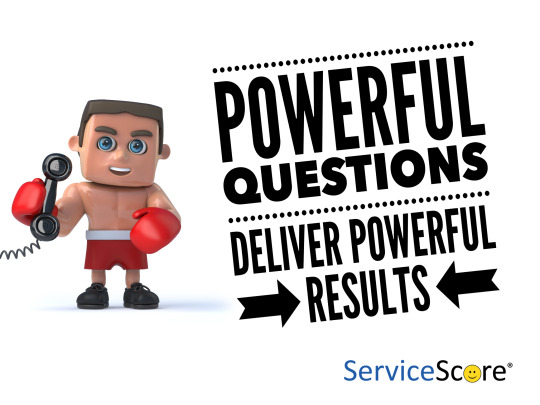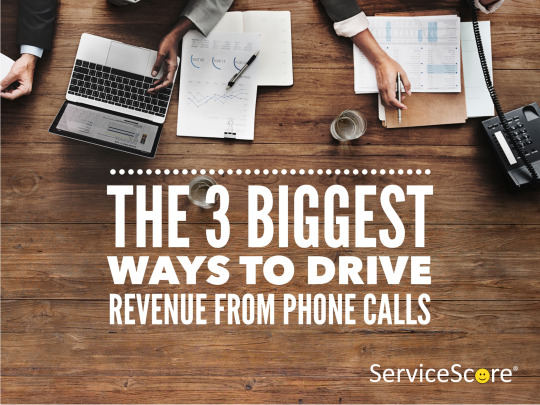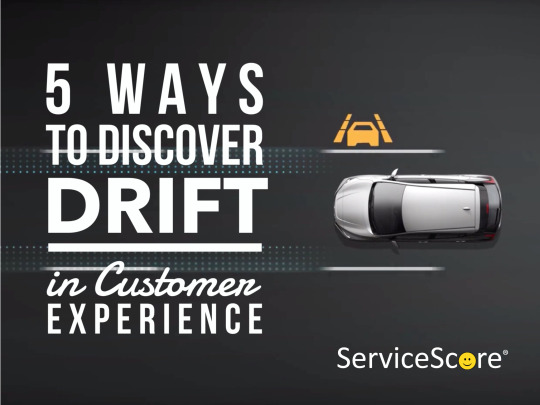Text
The Power of Powerful Questions

Every business wants to deliver a great experience on phone calls, but many managers worry that their staff is too busy to make it happen as often as they’d like. They assume that to truly build rapport and explain how their company serves customers, their team has to spend a lot more time on phone calls.
It might sound counter-intuitive, but our data shows that with effective skills, phone calls that convert to new business are more often shorter, not longer, in length. These calls follow a three-step process called “The Funnel Effect” with each step having its own set of Powerful Questions. It’s all about efficiently learning the caller’s needs, understanding what they value most and then offering the best solution.

The Funnel Effect progresses a phone call through 1) Open Questions, 2) Probing Questions and then 3) Closed Questions. There’s an assumption that to build rapport and sell value on the phone, one must ask many open-ended questions and let the caller just keep sharing until they run out of steam. Yes, open-ended questions are important, but closed questions are just as important – at the right points in phone calls.
Powerful Questions show the caller that you care and get them to talk specifically about the needs that your business can help them meet – which is why they called your business!
Let’s look at an example of Powerful Questions and The Funnel Effect for someone considering hiring a Maid Service for their home cleaning needs.
Step 1: Open-Ended Questions
After greeting the caller, asking for their name and determining that the caller needs your product or service, start with a powerful open-ended question to get them to tell you why they’re calling you today. The key to doing this efficiently is to have a deep understanding about the most effective Powerful Questions for your business. The right questions will help you quickly get to the true needs of the caller. In our Maid Service example, open-ended questions might sound like this:
“I’d like to ask a few questions to get you exactly what you’re looking for and then I can make a few recommendations, does that sounds ok, John? Great - Tell me, why did you give us a call us today?”
What kind of services were you considering for your home, Denise?”
“What’s going on with your home that you called us today, Sharon?
You can quickly learn a lot from these types of questions. In this example – the caller might not need Maid Service at all – or at least, not at first. This caller might just be overwhelmed and needs help with the laundry or might need a professional organizer – and house cleaning is actually a secondary need. The answer to these questions helps you start to learn the caller’s needs and opens the door for follow-up.
Step 2: Probing Follow-Up Questions
These allow you to narrow your understanding of the caller’s answers to your open questions – and to learn what they value most. This is where you have the biggest opportunity to build rapport and progress the call more quickly – by asking questions that allow you to offer the caller the right solution based on their unique needs and values.
In our Maid Service example, learning if a caller has ever previously used an outside provider can teach you a lot. It might sound like this:
“Tell me, John, have you ever had Maid Services at your home before?”
If they haven’t had Maid Service at their home before, you have the opportunity to find out why they’re considering it now – and what they might value most from the service. For example, you could learn that they’re looking to get more time back in their week for other activities besides cleaning or that they just started a job that takes them out of the house or that they are just not able to keep up and need some help to get the house cleaned at the standard they want to maintain. This gives immediate insight into what the team member should focus on when offering a proposed service. The caller might place the highest value of time savings, or the peace of mind of knowing that the work is done when caller is not at home or the sparkling results from great teams, tools and practices.
Yet, if that Probing Question helped you learn that the caller had used a Maid Service before, it can save you some time by not having to explain how the service works and instead focus on understanding why the caller is looking for a new provider. It might sound like this:
“That’s great Sharon, it sounds like you have experience with Maid Services for your home. May I ask, why are you considering trying a new provider?”
The answer to this question can get right to the heart of the reason for the call – and what the caller values most in Maid Service. For example, the caller might share that he had a bad experience with dependability (the team member can sell how they make sure that no scheduled services are missed) or that she was concerned about the trustworthiness of the person coming into her home (the team member can talk about the agency’s background checks and screening standards for employees) or cleaning consistency (the team member can talk about their cleaning checklist and proactive post-visit calls that make sure the job is done to the customers’ satisfaction).
You can see how the right Probing Questions at the right time on calls can show the caller that the team member is sincerely looking to pair the caller’s needs with a solution, while also saving time by not having to explain processes or sell features that aren’t relevant to the specific caller’s situation.
Step 3: Close and Confirm Questions
Asking closed questions towards the end of the call allows you to confirm both your own and the customer’s understanding of what has been discussed and gain commitment for next steps. It also adds efficiency by gently transitioning the call towards a successful close. You’re just looking for a quick answer, usually yes or no. In our Maid Service example, closed questions might sound like:
“Thanks so much for the call today, Joe. Just to confirm, we’ll meet you at your home on Cherry Lane next Tuesday at 9am for our in-home consultation, do I have that right?”
“Thanks Sharon, I’m happy to email you the information packet we discussed. Is it ok for me to call you next week to follow-up on any questions you might have?”
“Thank you, John, it’s great to review the estimate with your wife and I’ll email it to you right after we hang up here. May I call you tomorrow afternoon to follow-up?”
The best thing about Powerful Questions is that they can support the natural flow of conversation which makes calls more efficient and builds rapport. It the staff member answers a call with a genuine desire to help the caller become a customer, these questions can flow like any authentic conversation.
At ServiceScore, we help businesses use the insights from their Phone Call Performance Reports to identify and enhance the Powerful Questions that deliver an outstanding customer experience that convert more calls to new business.
Image Credit: Call Center Helper
0 notes
Text
We’re Here for You

These are uncertain times, for sure.
If you're looking for creative ways to keep your team productive and engaged in your business, we can help.
Like you, we want to keep the great team we’ve built learning and growing during this period.
That’s why, for a limited time we’re dedicating hours of our Connections Coaching at no charge to our clients (current, past and future!)
It’s all about creating better connections that help your team convert every opportunity call today, while building skills to be ready for faster growth when business conditions improve.
Sessions are great for team members working remotely or in the business with training time available.

These 30 minute video sessions are customized to your specific opportunities, using ServiceScore reports and industry metrics.
Coach the top 3 opportunities for improving conversion rates and customer experience, based on the data
Review your team performance reports and recommendations (current or past, with trends by team member)
Share our list of no-cost ways to market your business today to stay in touch with your customers and be ready for growth
Email us to schedule your no-cost session at [email protected]
We’re grateful for the opportunity to serve your business and dedicated to your success!
0 notes
Text
The 3 Biggest Ways to Drive Revenue from Phone Calls

1. Convert More Callers to Customers
Improving call conversion is one of the most cost-effective ways to help business owners improve profitability. Why? Because you've already invested in the advertising, the salespeople, the fancy phone system and the people to answer those phones. The value of being able to convert just a few more of those calls each week not only drives higher revenue, but dramatically improves the ROI of all those other investments.
For example, for a single location with 20 inquiry calls per week, moving the conversion rate from 46% to 50% can mean an annual revenue increase of $92,000. Better yet, that comes with no additional investments in sales, marketing, phones or people.
Using our ROI Tool, you can calculate the benefit to YOUR business from just a 4-percentage point improvement in inquiry phone calls converting to customers. Download the tool to see for yourself at www.servicescore.net/resources.
2. Deliver a WOW First Impression

“Customers have 8 experiences with your brand before they pick up the phone to call.” - Salesforce
After visiting your website, reading reviews and checking out social media, they’re finally ready to talk to you. The question is – does their experience on the phone align with what they’ve read online?
If your website promotes the brand’s expertise, but the caller gets someone who can’t answer their questions, they probably won’t take the next step.
Creating a WOW experience on the phone starts with powerful questions and a total focus on the caller. Sure, you have to follow a sales process, but what’s most important is building on what made them call your business in the first place.
A call that builds trust and expertise makes sure that everything you promise online is validated in their first human interaction with the brand – a phone call.
3. Up-sell to Bring More Value to Callers

What’s the revenue impact for your business if 1 in 5 of your customers added a $25 product or service based on your team’s sincere selling skills on phone calls?
HERE’S HOW:
SUGGEST COMPLEMENTARY ITEMS
It’s all about learning about the caller’s needs by asking about their project, business and challenges. This unlocks knowledge into ways team members can suggest products or services that help them reach their goals. Added services might include pick-up or delivery, installation, premium options, in-person visits.
CROSS-SELLING
By understanding the needs of customers, there are undoubtedly ways that your business could help beyond the caller’s inquiry. And in the off-chance that you don’t have the solution, you can refer the caller to other business partners that would love your referral, bringing more value to a new customer.
EDUCATING POTENTIAL CUSTOMERS
Even if a caller doesn’t bite on an offer to add more today, by educating them on the breadth of products and services offered, your business can create value for future sales.
SHOWING THAT YOU CARE
The best part about upselling is that, when you do it right, it’s based on great questions you’ve asked to learn what customers value most. A sincere suggestion on products or services that a caller might need can save the caller the time and effort in searching out another provider. You’ve built rapport and shown sincere, specific interest in helping your customer beyond the reason for their initial call.
Looking for more ways to get the most from phone calls to your business?

We’ve assembled the most important research and best practices from helping thousands of franchisees - and their franchisor leaders – get better results from inquiry phone calls.
We’ve organized these insights into 6 areas that impact the most critical areas of success:
1. Increase Revenue
2. Improve Customer Experience
3. Spark Innovation
4. Deliver Marketing ROI
5. Create World-Class Operations
6. Drive Profitability
Check out our eBook and "Give Voice to Your Goals" today at www.servicescore.net
0 notes
Text
5 Ways to Discover Drift in your Customer Experience

What’s the difference between a good and bad Customer Experience?
I was thinking about this after a small (but unwelcome) change at a sandwich shop I visit often. After coming four days a week for the past year, something was different. When I tapped my phone on the card reader to pay, a new message asked me to select the amount of “tip” I wanted to add. Suddenly, I had to decide with a line of customers behind me. Even though I believe in great tips for great service, I was annoyed that I was now being asked to pay extra for service after I stand in line to order, pay at the counter, fill my own drink, get my own chips, clear my own table and toss out my own trash. In other words, am I now expected to pay a tip like I’m at a full-service restaurant when I’m not getting any of the same services? And since I’m there often, do I really want to add $10 a week to my lunch budget for the same meal and service?
Here’s what bothered me the most: it felt like the rapport I had built with the cashier over many months seemed to evaporate when I hit “none” to the Tip Amount question and her eyes dropped and shoulders slumped. So, within a few seconds, I went from feeling like a good customer to Ebenezer Scrooge. Is it just me being “cheap”? I began to notice that I wasn’t the only one that seemed to feel annoyed when that tip message appeared. Especially with older customers, there was frequent face twisting when they hit the “none” button and our cashier, again, looked crestfallen. I’m guessing the change happened because the chain started working with delivery services, like Uber Eats and GrubHub, and had to make a change for driver tips. But I wonder if they considered how this might impact the experience for customers paying at the counter.
All of this got me thinking about “drift” – small changes upon small changes that can add up to a big gap between a customer’s expectations and reality. I was first introduced to the concept of drift early in my restaurant career as I was being promoted to Director of Operations, when our CEO gave me outstanding direction: “You have one job now – prevent drift in my restaurants”. Over the years, as a student of Customer Experience, I’ve looked at ways to identify these small, potentially harmful changes. The old rules of strategic advantage don’t apply anymore – we can’t wait for customer complaints or sales declines to know we have unhealthy drift. We have to define, then proactively protect, the core elements of the customer experience that customers value most. Here’s 5 ideas on how to get it done:
1. Define the Critical Few
In discovering drift, it’s important to first make sure your team knows what’s non-negotiable in the delivery of your customer experience. You can’t monitor everything, nor should you. Understanding those critical few aspects of your service delivery that creates loyalty is the key. Start from the perspective of your customers: where can you be so truly great that your customers will pay – and continue to pay for your services? A resource we love is the book, “Uncommon Service”, where Frances Frei and Anne Morriss show how service must become a competitive weapon, not a damage-control function. That means weaving service tightly into every core decision a company makes. This includes deciding on where your brand will be truly great and where you will be intentionally bad compared to competition (such as letting the other guys be great at self-service or low-price). The most important part of defining these critical few is building a process culture that ensures zero tolerance for “drift” in these core elements of your brand.
2. Who’s Responsible for the Customer Experience?
As the old saying goes, “If it’s everyone’s job, it’s nobody’s job”. Insights from the 2019 Annual Franchise Marketing Report, just published by Franchise Update Media, shows that in franchised brands, responsibility for the Customer Experience is most often shared, based on a national survey of franchisor marketing leaders. Specifically, when respondents were asked which department manages the “Customer Experience”, 45% shared that it is managed by multiple departments (with 35% stating that Operations manages and 15% stating that Marketing oversees). Having clear accountability for measurable aspects of the customer experience is a key to making sure your critical standards are vigorously protected.
3. Seek and Act on Customer Feedback
Once you’ve defined the core processes that deliver your differentiated customer experience and defined accountability, it’s time to build the mechanisms to help make sure they’re being delivered. Of course, you can look at sales trends, call volume and product mix, but if these lagging metrics are decreasing, you’re probably too late to easily make improvements. Seeking customer feedback in ways that make it easy for customers to share is important; outreach surveys via phone, email and mail are great, as are surveys in your brand app and on websites. Social media listening and monitoring online reviews are also key to both learning consumer sentiment as well taking the opportunity to join the conversation.
4. Consider the Root Causes
It’s easy to blame poor training or bad hiring when staff members take shortcuts or make changes that can impact the customer experience, but these tweaks can also be made by leadership, well-intended to benefit the business. Managers that cut service staff, ignore employee credential gaps or skimp on ingredients might see a fast benefit to the bottom line – but, over time, they’ll see their customer loyalty erode. So, part of preserving a stellar customer experience is to understand the pressures that might lead employees to drift – with the support of managers or owners:
· Franchise Satisfaction: Franchise Business Review (FBR) recently shared powerful insights gained from 23,604 franchisee satisfaction surveys completed in 2018. They found that brands with high satisfaction dramatically outperform brands with lower satisfaction on every key financial metric for a brand, including unit growth, turnover and – most importantly – franchisee income. In fact, highly satisfied franchisees (top quartile) had almost double the income vs. less satisfied franchisees (bottom quartile). Knowing this can tell you about your operation’s potential for drift in many ways. Most obvious is economic – simply put, if the business is making a good income, there is less financial pressure to cut corners in any area, including customer experience. More broadly, highly satisfied franchisees are less likely to allow drift. As FBR’s CEO Eric Sites puts it, “Engaged franchisees participate, are passionate about the business and feel a deep connection to the brand.”
· Recruiting Pressures: What impact can a great economy have on drift? With unemployment rates nearing a 50-year low, recruiting and retaining qualified staff is a challenge. Being able to merely fill shifts is difficult enough, but finding those stars with the core values the brand needs to deliver a special customer experience is extremely tough when candidates are scarce.
· Cost Pressures: tougher recruiting often leads to higher wages. Combine this with other rising costs of insurance, regulation and commodities and the economic incentive to find faster, cheaper and easier ways to serve customers heats up.
· Competitive Pressures: Moves by others in the industry to charge new fees, reduce service aspects or modify products can seem like justification for managers and owners to make their own changes – even if their brand leaders are trying to hold firm on core aspects of the service delivery.
5. Outsource your Eyes and Ears:
Yes, most brands have customer service supervisors, trainers and field consultants charged with preventing drift. These internal roles are important, but have limitations because their perspective is just that – internal. Their impact grows exponentially when they have the benchmarking data, industry insights and technology tools that make their jobs more efficient and effective. For example, online audit platforms can help onsite visits result in uncovering small, but potentially catastrophic examples of drift in your customer experience. The leading online audit platform, FranchiseBlast, recently published “59 Customer Service Audit Questions Your Franchise needs to Know.” These questions, from a variety of types of businesses, help auditors focus on items that directly impact the customer experience (such as speed of service, staff offering friendly greetings to guests) as well as less direct, but still impactful elements of the overall experience (each crew member wearing a clean uniform, background music sound quality, saying thank you after every transaction). At ServiceScore, we review recordings of actual phone call inquiries to thousands of businesses so that we can provide brands with real-life call conversion metrics, brand compliance concerns, ideas for new products/services and more – all from listening to (literally) the voice of the customer.
If drift is when identified early, these small changes can usually be reversed through great coaching. Even better, it can be the spark of an idea that leads to positive changes in the customer experience. Knowing what’s truly important to your customers and leveraging the right tools can help identify these opportunities – and take the lead in protecting those critical aspects that create customers for life.
References:
Franchise Blast Customer Service Questions: franchiseblast.com/customer-service-audit
Uncommon Service: https://www.amazon.com/Uncommon-Service-Putting-Customers-Business/dp/1422133311
Annual Franchise Marketing Report: https://afmr.franchiseupdate.com/
Franchise Business Review: https://tour.franchisebusinessreview.com/the-importance-of-franchisee-satisfaction-and-engagement/
0 notes
Text
5 Reasons to Invest in Bilingual Phone Staff

The Hispanic population is the fastest growing in the United States.
According to US Census data, the number is expected to reach 60 million in 2020 and increase by another 10 million over the next 10 years. While many Americans speak English as their first or second language, businesses that are able to smoothly serve both English and Spanish speakers have significant advantages.
1. Build Faster Rapport
One of the things our ServiceScore Account Specialists usually hear on calls where the caller clearly speaks Spanish as their primary language is their initial hesitation when the call is first picked up. The caller often has enough comfort with English to ask if there is anyone available that speaks Spanish. At that moment where a bi-lingual person is available (if he/she is not already the person who answered the phone), everything changes for that caller – they’re immediately more comfortable and able to get right to the purpose of their call.
2. Handle Inquires Faster
Along with the clear advantage of a bi-lingual team member being able to help someone with a Spanish phone inquiry more efficiently, there is also a lot of time saved when that first person that picks up the phone speaks Spanish – rather than someone who only speaks English having to put the caller on hold to try to find someone else to handle the call.
3. Better Business Performance
According to a study by AnswerNow and noted by CRMExchange, contact centers that have bilingual agents perform better than single-language contact centers, both financially and operationally. One reason is the opportunity to hire less bilingual agents vs. having to have both Spanish and English speaking staff. Hiring is critical to make sure that agents understand the “business” language and terms needed in Spanish along with more than a passing understanding of English to clearly understand the needs of the caller and avoid having to put him or her on hold for help with translation.
4. Tailored Caller Experience
In addition to understanding the language, many bi-lingual team members will understand (and expect) cultural differences that often exist with Spanish speaking callers. According to research done by Peter Ryan of Ovum (Contact Center Outsourcing) Calls tend to be longer due to asking more questions and spending more time in initial rapport building than with the average English-only speaking American. He adds, “If you’re not ready for someone looking for more information or support, it might prove to be surprising”.
5. Higher Brand Affinity
When a caller understands that a local business or call center has invested in talent that can serve callers in multiple language, this can have a very positive impact on brand affinity and customer satisfaction. Even if a caller themselves doesn’t need bi-lingual services themselves, when they understand that their family, friends or others in their community can be served in their native language, there is a great opportunity to be seen as truly investing in their customers.
ServiceScore helps businesses get the results they want from phone calls – in English or Spanish. Our call performance reports along with strategic insights help front-line team members turn more callers into customers. Learn more at www.servicescore.net.
0 notes
Text
Your customer’s second choice requires a great first impression

Phone calls aren’t your customers first choice. That’s why they’re so important.
Why are you calling?
Let’s face it, few of us look forward to calling a business for the first time. We’re not sure what to ask, who we’ll be talking to or how quickly we can get in and out of the call and onto the rest of our day. Just seeking this information can be stressful. So why are we calling?
We have questions.
Not long ago, phone calls were the very first step in our relationship with a business. We’d go to the yellow pages and inquire about the product or service we were looking for. Today, we start with an online search for answers that we used to only be able to get from picking up the phone: Where are you located? What are your hours? What types of products and services do you offer? Can I get it today? With so much information available online, if a potential customer is calling your business, they’re looking for something very specific that they couldn’t find – or do – online. They want to know how to get started with your business, get a price estimate or understand how the product or service works.
That’s why calls are so important.
There’s a reason that 57% of smartphone users call a business after searching on their phone, according to a recent study by Google: they want to talk to a real person. Simply put, if someone is calling, they’re ready to do business with you. They’ve already been to your website, checked out reviews or have a personal referral. They’re calling today because they have a question or want to take that next step – get a price, schedule an appointment or place an order.
And calling is easier than ever.
Today’s tech drives this process and makes it easy. With the majority of searches happening on a mobile device, when someone is ready to take that next step, it’s easiest just to call the number that comes up in search. That’s why 61% of mobile searchers say that click-to-call is most valuable in the “purchase phase”, according to a study published recently in Forbes.
First impression is everything.
Your raving reviews and wonderful website have made the customer want to take that next step to call your business. This makes phone calls an even more critical step in the customer journey. The good news is that the caller probably already knows a lot about your business based on what they’ve read online or from a personal referral – the bad news is that, because of this, their expectations are high that they’ll receive a warm, streamlined, personal approach to help them take the next step. In other words, if someone is investing their time in a placing a phone call to your business, they expect – and deserve – an experience that makes them believe all they’ve read about your business and trust you to serve their needs.
Phone calls might not be your customer’s first choice to reach out, but there’s so many reasons why it’s the best choice when someone wants to get started with your business. Delivering a WOW first impression validates the reason that a customer called you in the first place – and gives your team the opportunity to help the caller take the next step in becoming a customer for life.
0 notes
Text
What’s your Brand’s Super Power?

A few weeks ago, on I was on a call with a customer who asked me a question that caught me off-guard. “I believe that everyone has a Super Power – what’s yours?”. It was a great question from a very successful multi-unit, multi-brand business owner. I’ll share my answer at the end, but it got me thinking about the impact we see when a team member effectively communicates what’s special about their brand to a potential customer on phone calls.
Brands that win at building customer loyalty know that their Super Powers are the ways they’re better than their competitors – and better at making sure consumers know it.
Think about the Super Powers held by some of the biggest companies in the world. When you think of Netflix, you might recognize the power of the data they harness from subscribers to fuel content development, present users with shows that “match” their interests and find new ways to keep you on the couch watching just one more episode. How about Apple – Steve Jobs championed a lasting culture that values quality, focus and privacy behind the innovations used in 1.5 billion devices worldwide.
Enriching lives with your brand’s Super Powers takes skills in both developing brand differentiation – and in how you tell the story.
At ServiceScore, we spend a lot of time thinking about ways to help team members communicate what’s special about their brand on the phone. We see this as one of the most important aspects of a conversation that converts more callers into customers. Here’s why:
1. Give a Caller a Reason: If a potential customer is calling your business, they likely have need for your product/service and they have enough information about your company to consider doing business with you. But it’s just as likely that yours isn’t the only business they’re calling. How will they know they should choose your brand over any other?
2. Make it Last: When a caller becomes a promoter for your business, making sure they know your Super Power makes it easier for them to credibly recommend you to their friends and family.
3. Validation: If someone calls your business they’ve probably already checked you out online – website, social media or reviews. And if, after that research, they’ve clicked through to call your business, they found something compelling that prompted them to call. It’s the job of the team member who answers the phone to share what’s special about the brand – so the caller starts to build trust that what they’ve read is valid, based on hearing it repeated by an actual brand team member.
The trick to showing off your Super Powers is to only show off some of your Super Powers.
Think about Superman. He’s got flying, super-strength, freezing breath, laser eyes and more. But if you’re stuck in a tree, what’s important to you is that he can fly up and help get you down. Those other super powers are interesting – but aren’t relevant to the immediate needs that made you call out for help from Superman.
It’s the same thing when someone calls your business. Sharing ALL your Super Power differentiators on a call can be worse for building a trusting relationship than not sharing any at all.
The trick is to ask 1 or 2 Power Questions early in the call to understand where the caller is at on their journey and what’s most important to him or her. Then, as you tell them how you can help meet their needs, you can weave in those special aspects of your brand that have the most relevance – and therefore importance – to the caller.
What’s ServiceScore’s Super Power?
When I was asked this question by that savvy customer, I told him that our Super Power is Diagnosis. We’re really good at creating platforms and processes that quantify key aspects of phone call performance. This helps businesses know their current performance level with evidence-based areas for coaching – and the ability to track progress and correlations to other key business metrics of success.
The fastest, easiest and most effective way to coach a culture of sharing your brand’s Super Powers is by reviewing real phone calls. Practicing the skills of asking power questions that unlock what’s most important to callers, helps team members better share what’s unique and special about doing business with their company.
The ServiceScore team can help you with the diagnostics, strategy and results that create a more trusting, effective first-phone call experience with your brand. Give us a call. We’d love to make sure the world knows about your amazing Super Powers.
0 notes
Text
The Most Important Two Words in Business
But are you doing it right? Learn the three parts of a “Power Thank You” and the value of building a culture of gratitude.

We get asked what surprises us the most from our data on phone call performance. With thousands of calls reviewed each month, we’re able to see opportunities across brands and industries. What is most consistent is a lack of saying thank you at the end of a call with a new prospect or customer.
It’s not surprising, if you think about it. If someone is calling for a price, appointment or the answer to a question, after the team member handles the inquiry, they’ve done their duty. The caller usually thanks the staff member for the information, for which the team member usually says, “you’re welcome”. So, what’s wrong with that?
Consumers are armed with more information and choices than ever. With many industries becoming more crowded with competitors every year, setting your brand apart based on the customer experience is not only an opportunity – it’s vital. An average consumer will have been to your website and read reviews before they call your business for the first time. But if they’re calling, they’re ready to take that next step – schedule an appointment, make a purchase or get an answer to a question they can’t find online. To win the business, your team has to go beyond being knowledgeable and polite – they have to show sincere gratitude that the caller chose to take that next step with your brand.
Saying thank you, more than any other element of a phone call, can yield lasting value for your brand.
Gino and Grant published a study in the Journal of Personality and Social Psychology showing the link between expressions of gratitude and prosocial behavior. When someone receives a sincere thank you, they are more likely to act, reciprocate the assistance they receive and even show higher levels of “helping” such as promoting the brand to others. Better yet, these expressions of gratitude benefit both partners in this social exchange, according to the research. In other words, it not only adds value for the caller, but can lead to higher levels of job satisfaction for your team.
Putting this to work in service coaching starts with a culture of gratitude for a prospective new customer and the opportunity to help. A phone inquiry represents a new chance to grow your business – not a distraction or time away from what your team was working on. Being asked for a quote or question is a privilege; your investments in selling and marketing made the phone ring! We’re not doing the caller a favor by helping – they’re doing us a favor by giving our business a shot at serving their needs. They deserve our expertise and help – along with our sincere gratitude.
Make the most out of this opportunity with something real and memorable – the “Power Thank You”.
Harvard Business Review contributor Mark Goulston introduced this idea which we’ve adapted here. A Power Thank You has three parts on phone calls:
Thank the caller for something specific. Example, “Sharon, thank you very much for the opportunity to put this quote together for you. We appreciate the opportunity to help you with your project.”
Recognize and acknowledge the effort the caller made, for which you are grateful. Example, “Joe, thanks a lot for calling us today. I know you’re just starting to call around for estimates, but we’re really grateful you gave us a shot to earn your business.”
Tell them what it personally meant to you. Example, “Sam, it’s been great talking to you and we’re so grateful for your order. You’ve made my day!”
The fastest, easiest and most effective way to coach this culture of service and gratitude is by reviewing real phone calls. Most of us think that we’re saying thank you and agree that it’s important. But when they hear recordings of our phone calls and see the data that this is missing this over 50% of the time, it’s a game changer. For most, an openness and humility to change comes from this awareness – of what the team member is not doing and that it’s important to the brand.
The ServiceScore team can help you with the diagnostics, strategy and results that create a more trusting, effective first-phone call experience with your brand. Give us a call. We’ll be very grateful for the opportunity!
Reference: “How to Give a Meaningful Thank You”, Mark Goulston, Harvard Business Review,February 13, 2013. Grant, A. M., & Gino, F. (2010). “A little thanks goes a long way: Explaining why gratitude expressions motivate prosocial behavior”.
0 notes
Text
5 Ways to Drive Revenue from Phone Calls
youtube
When a customer calls your business, there’s 1000 different ways that call can go. We figure out the best way and help our clients get the results they want.
For most, the top priority is turning callers into customers. But increasing conversion is just one of the ways that we obsess about helping brands get the most every phone call.
Our experience shows that there’s actually 5 ways to drive revenue on the phone.
These calls are already coming into your business. Let’s make the most out of every one of them.
The first way to drive more revenue from phone calls is by delivering a WOW first impression.
Consumers have multiple experiences with your brand before they pick up the phone to call. After visiting your website, reading reviews and checking out social media, they’re finally ready to talk to you. The question is - does the experience on the phone line up with what they’ve seen online? If your website promotes your brand’s expertise but the caller gets someone who can’t answer their questions – they probably won’t take the next step.
Creating a WOW experience on the phone starts with a powerful greeting with total focus on the caller. We help our clients ask questions that make a real connection. Sure, you have to follow a process - but what’s most important is building on what that made them call you in the first place.
The second way to drive revenue from calls is learning what’s driving your best leads – and doing more of that.
Even though the customer journey usually starts online, most customers still prefer to call after they’ve done their research. It’s just the easiest way for them to ask questions and take the next step. For example, in home services, over 70% of consumers want to call to make an appointment after they’ve found the business online.
We help marketers use data from calls to analyze their marketing ROI. By using call tracking numbers, we identify at how ready a caller is to make a purchase if they came from the company’s website vs. a review page vs. a social post.
The result is a smarter marketing spend, more great leads and an exceptional experience for the caller.
The third way to drive revenue on phone calls is by identifying areas for innovation. By listening for gaps between what callers are asking for and what you offer, we help you stay ahead of the competition.
For example, we help brands identify new payment options, like a way to finance a large repair bill. We might hear customers asking about a product feature that might not exist today, but is a great idea. The richness of this data gives businesses options to innovate – either by inventing new products - or creating better sales training for what they already offer. Either way – phone calls deliver many ideas that help sell more and create more – and both drive more revenue for your business.
The fourth way to drive revenue from phone calls is by cross-selling complementary products or services.
Not everyone feels comfortable doing this, but as sales guru Jeffery Gitomer reminds us, “no one likes to be sold…but everyone likes to buy”. The job of a customer service rep or agent – at its core – is to bring value to everyone they come in contact with.
It’s all about asking the right questions and connecting the best solutions. It’s like this: “Did you know that in addition to carpet cleaning, we can also clean your tile on the same visit? “Would you like us to give your dog a bath when he’s with us for day care?” “Our table-top signs would look great with that pop-up banner you’ve ordered!”
Even if just 1 out of 5 callers took you up on a suggestion like this, what would that mean for your business?
Better yet, you’ve told the caller about something they probably didn’t know you offered. And you’ve shown that you cared enough to learn their needs and make helpful suggestions.
The fifth way to drive revenue from phone calls is by converting those callers to the next step.
This is all about giving compelling reasons to move forward with a follow-up quote, in-home appointment or purchase.
Make no mistake – if a consumer is calling your business, chances are they’re ready to buy. With click-to-call, it’s so easy to connect to a business right from a mobile ad. That’s why a recent study showed that 61% of searchers find click-to-call most valuable when they’re ready to make a purchase.
ServiceScore helps frontline team members become the ultimate closers. It all comes down to showing the caller that moving forward is easy and there’s a real benefit in doing it today.
0 notes
Text
Always Be Helping
“Always be closing” is over. Now, help first.

At first, the idea of “helping” consumers find what they need might sound like a distraction. What if it means helping them learn about a product you don’t offer? What if it leads to them choosing (gasp) a competitor? How ever you think about it, today, putting the customers’ needs before pushing for the sale is simply required.
Now more than ever, customers have a strong sense of empowerment. They demand outstanding service and direct companies how to satisfy needs. Technological advances have created faster, easier ways for consumers to learn about their options, read reviews and find a brand they trust. When they finally decide to pick up the phone to connect with a representative of that brand, it’s because they need something they can’t find elsewhere. Maybe they need a price quote or simply can’t determine if you offer what they’re looking for.
Helping doesn’t mean abandoning a focus on bringing value to customers with your services. It just means that your selling approach has to evolve to “Help First”.
In a recent article published by Hubspot, Dan Tyre shares three proven strategies to “Always Be Helping”.
How to Always Be Helping: 3 Strategies
1) Determine if the prospect has a problem you can solve.
If the prospect has a problem completely out of sync with what your company offers or doesn’t need any help for the foreseeable future, get out! They don’t want to talk to you, they don’t need to talk to you, and chances are you don’t want to talk to them.
Why?
Because you can’t help everybody, and you shouldn’t be. Working bad leads is like throwing money down the toilet. Picking and choosing who to help is a significantly better use of your time.
If you pick correctly, you’ll have no problem making 110% of your quota every month. But spending an equal amount of effort or time on every prospect -- no matter how qualified or unqualified they may be -- is a surefire way to continually miss the mark. Not only is it a bad use of your time, trying to sell to prospects without business pain is a bad experience for the buyer.
2) Understand where your prospect is in the decision-making process.
The kinds of conversations you engage in and questions you ask your prospects should vary significantly depending on what point they’re at in the buyer’s journey.
Awareness Stage: Your prospect knows they have a problem they want to solve, but hasn't decided upon a solution or begun to do vendor research. Salespeople usually won’t get involved in the awareness stage, since marketers generally control lead nurturing at this point. If you do reach out to a prospect who’s in this stage, use an extremely light touch or pass them back to Marketing.
Consideration Stage: Your prospect is aware of their problem, and is committed to spending time and effort to come up with a potential solution. At this point, potential buyers will begin to sniff around the edges of a resolution, but won’t have defined how much of a material commitment they’re willing to make.
Decision Stage: Your prospect has thoroughly researched their problem and potential solutions. They might not have a specific vendor in mind yet, but if your company’s a big player, they’ve probably at least come across your resources. This is also the point where BANT (budget, authority, needs, and timeline) gets defined.
3) Tailor your process to make it easy for the customer to buy.
Always Be Helping means giving up control of the buying process. It does not, however, mean that salespeople are obligated to let prospects drive the bus. Strike a balance between how your prospect wants the process to play out and using your expertise to guide them in the right direction.
Your value in the sales process is that you, unlike your prospect, have successfully sold this product many times before. They don't know how to get internal buy-in or structure a process that will get them the solution they need.
But you do.
Work with your prospect to understand their decision-making process and the perspectives of all relevant stakeholders, and then use that information to sell your product successfully.
For many people, the process of buying is as important as the purchase itself. Prospects need to feel like they’re being heard and respected, and forcing a cookie-cutter sales process on them won’t work.
Ultimately, the Always Be Helping salesperson has to establish trust and confidence before they can close the deal. Modern salespeople help their prospects connect the disparate dots to form a coherent solution. The era of the intimidating, fear-inducing "always be closing" salesperson is officially over -- and that’s a very good thing.
0 notes
Text
Time Is Money

Don’t compete on price, compete on time
In helping brands increase their conversion of phone inquiries to new business, we often get asked for the most effective techniques.
Making trusting, expert connections on the phone takes a variety of skills – and applying them effectively is unique to every call (or, at least it should be).
But our experience – and some compelling outside research – shows that the #1 way to influence a caller to take the next step (whether that’s an estimate, an in-home appointment, or a consultation) is by showing multiple dimensions of value. More specifically, how you can save them time.
Think about it: If a caller is picking up the phone to call you, they’ve likely already been to your website, read online reviews and maybe even had a referral from a friend. They already know that when they call, they’ll be asked for that that next step – they just don’t yet know why they should take step. If you can show the caller that your product or service will save them time beyond what they’d expect, your conversion rate goes through the roof.
Here’s how it works
Let’s say you’re calling around looking for companies that can clean your office suite on a weekly basis. Your goal is to get someone to change out the trash cans, vacuum and dust once a week. You’ve done your research and you know approximately what you should pay for that service.
Then you start calling 4 brands you found on Google to get prices. Three of the four answer your question and give you a quick, courteous price quote. The fourth takes another few moments to understand your business and identify other ways they can bring value while they’re onsite:
They ask if you have a breakroom and a kitchen and if that’s a key area of cleaning focus.
They mention that they bring in their own cleaning tools and supplies so you don’t have to run out to purchase those anymore.
They ask if you have restroom supplies that need to be checked and refilled.
They mention that they sanitize desk tops and phones to remove bacteria and contamination to help reduce employee illness and absenteeism
And if they’re really on their game, and understand that price is important to you, they’ll share that these services are unique to their company.
So now you’ve got a company that can do the job you want…plus they’ve given you multiple additional things that you don’t have to do or even worry about if you go with them. If their price is competitive (maybe even within 10% of the other three) aren’t you more likely to choose that fourth company?
You might think this is common sense, but it’s not common practice. In a study reported by the Wall Street Journal (“Beat the Clock: How companies use time to their competitive advantage”), only 5% of consumers surveyed found that any company they do business with always respects their time.
Three ways that brands can win on selling time as value
1. Help consumers do things faster
2. Make the product or service easier to buy
3. Make the time involved in using a product or service more pleasurable
The takeaway here is that all three of these can be won – or lost – by the experience and value-selling during an inquiry phone call to your business.
Being great at asking the right questions in an authentic way that reveals ways to connect customer needs to company value is not always easy. When you take best practices across industries and brands and show, objectively, the techniques that are driving conversion, that’s where the magic happens.
ServiceScore helps business get more customers through increased conversion. Individual call reports showcase areas for improvement, while data across many calls gives executives the best practices and insights that raise performance across an entire brand. Give us a call. We promise that it will be a great use of your time.
0 notes
Text
Three Reasons Why Your Customers Still Want to Talk to a Human
Score one for people (sorry, Siri)

Many of us are spending more time with the ever-expanding capabilities of our voice digital assistants. But when it comes to making a trusting customer connection on the phone, Siri falls short. A recent Competitive Strategy article in Harvard Business Review illustrates why (effective) phone calls with human beings are still great for business.
Forms aren’t fun
The mobile revolution has shrunk the workspace we have for filling out forms or searching for information. Your iPhone is a great source for a start of these tasks, but doesn’t take you far. This is where phone calls are critical and being shown as preferred by trends in consumer behavior. Filling out a form on a five-inch screen is a much clunkier experience than calling a business directly from a search result or a Facebook ad. According to the advertising and marketing advisory firm BIA/Kelsey, calls to businesses are expected to exceed 169 billion per year by 2020. These calls are 10-15 times more likely to generate a successful sale or follow-up activity than digital form submissions, which means they are more efficient in generating revenue.
Calls are more efficient
According to a study by Google, 61% of mobile users call a business when they’re in the purchase phase of the buying cycle. The majority of respondents would call instead of reach out online because they’re looking to get a quick answer (59%) or talk to a real person (57%). The study also found that consumers are more likely to call a business when making a high-value purchase in verticals such as auto, finance, or travel.
Call data adds to more complete marketing attribution
The article references an example of the complexity of understanding the full impact of advertising on overall revenue, particularly downstream in the consumer’s journey and with add on products or services. a major hotel chain invested heavily in online search ads for one of its resorts with a well-known golf course. While analytics revealed a high click-through rate on the ad, it showed little evidence of actual hotel bookings, so the company decided to pull the ad. Just before doing so, the team ran a test to match the ad with calls made directly to the hotel, revealing that people would not book a room unless they could get a tee time — something that could only be booked over the phone. The ad actually worked tremendously well, but the company lacked visibility into the calls that resulted from it.
For advertisers, all this means ensuring that the brand experience starts with the right touchpoints to optimize the points that your customer interacts directly with your brand as they start their journey:
Optimizing advertising for easy click-to-call by consumers and job seekers
Making sure that a live-voice phone call option is available when customers are seeking more information or are ready to make a “considered purchase” (higher price or complexity – or both)
Be ready to enhance – not replace – your automated voice platforms with human interaction. For example, ensuring that digital assistant connections to your brand allow for easy contact with local outlets or customer service representatives
Understanding and embracing new customer contact technology is critical to winning in rapidly changing industries. The research shows that it’s just as critical to ensure that these efforts enhance – rather than replace – trusting, expert connections between human beings.
Reference: “Your Customers Still Want to Talk to A Human Being” by Gregg Johnson, HRB.com, July 26, 2017
0 notes
Text
Q1 done. 3 to go.
Did you hit your goals in Q1? How about another $8700 in monthly revenue per location in Q2? Whether you’re looking to build on great momentum or looking for new ways to move the needle, one of the fastest, easiest and biggest revenue opportunities for your business is on the phone. Let’s blow past your Q2 goals by converting more customers that are already calling.

Say the average lifetime customer value for your brand is $1000. If a location gets 50 inquiry calls per week and you can convert just TWO more of them to a customer, this would mean an additional $104,000 in annual revenue ($8667 per month). For a franchise system with 250 locations, that would be $26 million in additional annual revenue!
The best news is that the profit goes right to the bottom line – you’ve already invested in the phones, people, sales and marketing. You’re just getting more from where you’ve already invested.
Here’s how to get started:
1. Know your conversion rate and set goals to improve- either by industry, or your franchise system or by your own performance. You want to track inquiries, not just how customers found out about you. If you don’t know what’s driving calls, you might be losing out on valuable insights. Performance of marketing and advertising initiatives, performance of team at converting the calls, not to mention confirming that customer calls are being answered in the first place!
2. Understand what’s driving conversion rate – it might be a number of things. Are team members asking great questions that get to the heart of the caller’s needs? Are they connecting the unique factors of your brand to those needs to showcase the value only your business can deliver? Are they showing empathy for the caller’s situation and making an expert, trusting connection? Are they comfortable asking for the order or in-home appointment?
3. Coach and Track Improvement – You might not be taking calls in your own business, but there’s many ways to assess the quality of your team’s phone call performance. Do you ever have a friend or relative “mystery shop” one of your locations? Do you have all or some of your calls recorded? How often are you digging into these to listen to how your team is handling customer inquiries? Identifying gaps in customer service and phone selling through real calls can spur effective role playing and improvement initiatives.
It all comes down to understanding the current state of your team’s ability to make trusting connections with callers that result in new business – and putting the right tools in place to review and improve inside sales effectiveness.
ServiceScore can help. With reports that combine your brand customization with sales best practices, along with the insights from across your multi-unit enterprise or franchise system, we make improving call conversion simple and effective. A small investment in reports and insights from ServiceScore can deliver big dollars for your brand and franchisees.
Let’s head into Q2 with the data and tools to blow away your growth goals through better connections that lead to more customer conversions.
0 notes
Text
Are you a “Considered Purchase”?
Industries are seeing more calls to their businesses and it’s driven by two factors: they offer high-value purchases or provide products/services where customers typically desire personal assistance. With the volume of mobile phone calls to businesses projected to double between 2014 and 2019, we’re sharing the call trends from the 9 industries with the greatest increase. The top 3 are Home Services, Insurance and Computer Electronics – learn about all 9 and what’s driving call volume.

According to a study by BIA/Kelsey, mobile phone calls to businesses will reach 162 billion by 2019. That’s more than double the 77 billion generated in 2014. The call intelligence group Invoca analyzed 58 million calls and published a study that showcased the 9 industries that are experiencing the largest increases in call volume.
Here’s the list, along with average call duration:
1. Computer Electronics – 9:06 minutes
2. Home Services – 6:39 minutes
3. Insurance – 5:22 minutes
4. Financial Services – 5:02 minutes
5. Travel – 3:40 minutes
6. Health and Wellness – 3:22 minutes
7. Education – 2:42 minutes
8. Auto – 1:39 minutes
9. Legal – 1:20 minutes
There’s a huge impact from mobile advertising and click-to-call capabilities.
In Home Services, for example, marketing to audiences on mobile generated 62% of the call volume. Most of these came from mobile search, with 43% of calls coming directly from Google search ads. In another example, mobile search was the biggest source for education phone calls, with 38% of the total call volume. Education is seeing more calls from mobile specific channels – up 66% vs. 2014.
Offline advertising still has a large impact on call volume to businesses.
Calls to automotive are generated from offline sources 54% of the time. However, that’s down from 79% in 2014, where mobile channels are now generating 28% of calls.
Call duration is increasing.
Since 2014, call duration has increased 18%. The assumption is that marketers are doing a better job generating quality leads, based on a richer understanding of what type of person is most likely to call – and then targeting marketing to those best prospects.
If your brand is getting more calls - or just looking for ways to maximize the ROI of calls already coming in - ServiceScore can help. We serve multi-unit brands to measure and coach improvement that creates trusting connections on the phone that lead to more customers. Visit us at servicescore.net, or better yet, call us at 414-436-0040.
0 notes
Text
Does Your Marketing Help You Win Mobile Recruiting?

You already know that Marketing is Recruiting and Recruiting is Marketing. The question is – are you measuring the impact your marketing investments are having on your brand’s success in converting job seekers to apply and interview?
Constraints to growing your business aren’t more sales leads, but probably depend on recruiting more qualified employees to meet demand. Being great at hiring experienced staff in service industries like home repair, cleaning, painting, fitness, automotive, healthcare and other personal services is a critical competitive advantage. The battleground is on Mobile. Here are three ways to win.
1. Optimize EVERYTHING for Mobile
This sounds obvious, but it’s more than making sure your job postings are viewable on an iPhone. You know the impact that Millennials are having on mobile job search – according to the Indeed Hiring Labs study in July of 2017, 78% used their mobile devices to find jobs in 2016 - but did you know that 73% of Gen Xers and 57% of Baby Boomers did, too?
For recruiting in service industries, this is even more critical. Why? Those job seekers aren’t sitting at a desk – they’re often traveling to different work sites and spend time during breaks or after their shifts on their mobile devices. They don’t want the hassle of filling out pages of online forms on these small screens just to learn more about your career opportunities. If they see your brand in a job search, they’re more likely to use click-to-call to talk to someone who can tell them more about opportunity and then they’ll decide if they want to invest the time in filling out an application or coming in for an interview.
Beyond optimizing job listings for search, large national brands are leading the way in creating attractive employment brands, supporting their team members in showcasing examples of living brand values on social media. Target’s #targetvolunteers campaign is a great example:

Positive impressions that portray the “why” of working for a brand connect with job seekers at all stages of their search – awareness, consideration, preference and conversion.
2. Capture and Track Data at Each Stage
You’re probably already looking at your company’s recruiting process like a sales funnel, but are you capturing data at every point to see how your marketing investments are impacting recruiting success?
Data to Track: You might already be looking at metrics such as website visitor to applicants. But are you tracking what percentage of calls from your AdWords campaigns are generating employment inquiries? Or what percent of those inquiries are converting to an interview? Data about what drove a recruiting call is as important as what you track for online customer conversions (marketing channel, specific ad, search terms, web page they called from, etc).
Data to Benchmark: Tracking key recruiting metrics is only as valuable as understanding how to drive improvement across overall industry benchmarks as well as by region, job type and more.
Data that’s Meaningful: As in consumer marketing, there are many metrics you can track – not all represent key measures of success. Choosing the metrics that help quantify and allow you to optimize your investments at the critical points of the candidate’s recruiting journey should be prioritized.
3. Ensure a Great Employment Inquiry Experience
According to a study by American Express and OnBrandGroup, 84% of those surveyed would cease doing business with a company after a negative call experience and 55% who intended to make a purchase changed their minds because of a poor call experience. What’s true for consumers is true for job seekers – making a trusting connection on the phone is critical because the best, high performing employees have many job opportunities.
Knowing that everyone who answers the phone is making a meaningful connection with a job seeker by enthusiastically sharing what’s special about working for the brand and taking specific steps to make it easy for the caller to take the next step are critical skills for everyone answering calls. Investing in deep understanding of what works for creating this connection and urgency to take the next step in the employment journey with your brand, gives you new weapons to beat your competition on the mobile battlefield of recruiting.
At ServiceScore™, our mission is to help businesses get more customers and employees through better call conversion. With unique technology and experienced insight, we help multi-unit brands create better connections that lead to increased conversion. www.servicescore.net
0 notes
Text
Why Does ServiceScore™ Work? It’s No Mystery.

Effective coaching to improve inquiry call conversion is critical for driving revenue growth. For years, mystery shop reports have been used with the hope of moving the needle, but franchisees tell me why these “fake calls” don’t enable real improvement.
1. It wastes people’s time
I often hear franchisees talk about the time they spent 20 minutes on the phone with a “potential customer” when it was really a mystery shop call - while at the same time, real inquiry calls that came into the office weren’t answered.
2. People know it’s a ‘fake call’
A franchisee told me, “My team always knows right away it’s a mystery shop call – and then they spend their time saying things that they wouldn’t normally say because they know it’s about getting points from the reviewer, not about actually connecting with the caller and getting the appointment.”
3. No Learning to improve training
Because the calls are staged, the team isn’t practicing overcoming actual objections or connecting to real customer needs. This makes it impossible to use the actual Voice of the Customer (or Job Seeker) to improve training because you’re not hearing from people calling with real needs.
4. Just customers, not job seekers
Advertising drives calls for employment, not just for service. Mystery shop scenarios on customers miss the opportunity to use reports to also improve the conversion of employees to interviews. With many companies struggling to find experienced job candidates, being great at converting employment inquiries is really important.
5. It’s inefficient and costly
Wasted time on fake calls along with inventing and managing fictitious scenarios, makes mystery shop programs a questionable value.
Now there’s a better way. ServiceScore takes the mystery out of converting more calls.
We report performance using recordings of actual consumer and employee inquiries to bring Franchised brands a real solution.
Better Conversion: ServiceScore technology uses the data from 1000’s of calls to bring you insights and best practices on what’s working (or not working) across your brand, to get more customer and employee appointments.
Better Coaching: With reports and recordings from real calls sent directly to franchisees or contact center team members, coaching is more credible and effective.
Better Value: ServiceScore eliminates the distraction and inefficiencies from managing made-up scenarios that are part of mystery shop programs. By re-purposing the recordings of calls already in place, we deliver reports that have higher value…at a lower cost.
Best of all, Franchisees know their team’s time is being spent efficiently because their ServiceScore reports enable credible coaching based on how well they’re converting real customer or employee opportunities.
We’d love a chance to share how ServiceScore can help YOU take the mystery out of higher call conversion for your company!
Contact us at 414-436-0040, [email protected] or learn more at www.servicescore.net
🙂🙂🙂🙂🙂🙂🙂🙂🙂🙂🙂🙂🙂🙂🙂🙂🙂🙂🙂🙂🙂🙂🙂🙂🙂🙂
0 notes
Text
How I Caught Entrepreneur Fever

It didn’t seem contagious, but after 30 years in Corporate America, I somehow contracted Entrepreneur Fever.
You know the symptoms, right? Your heart starts racing, your brow is raised in “what-if” and you start seeing strange visions of a new way of doing things.
I thought I was immune to this bug. I’ve had a rewarding career in both healthcare and foodservice sectors of franchising starting with (this is going way back) putting Whoppers through the broiler at Burger King, then operations and marketing management, progressing to C-Suite marketing and operations at the leading Home Care and Medical Staffing brand, BrightStar Care. It’s at BrightStar that the fever really took hold.
I think if I had to pinpoint the source of catching Entrepreneur fever, patient zero has to be BrightStar’s CEO and Founder, Shelly Sun. In 8 years with BrightStar, I had the privilege of rolling up my sleeves – along with Shelly and the talented team she’s assembled – to help grow the brand to over 320 locations across the US. Her vision and drive to help Franchisees succeed are reasons why she is often referred to as the ���Consummate Entrepreneur”.
Shelly’s vision and smart business model has inspired hundreds of enterprising Franchisees to join BrightStar Care to own their own business. I’ve had the privilege of supporting these Franchisees who, in their own fever-induced state, combined their talents with a proven business model to build great businesses.
And all of this exposure led to the idea of leveraging my experience and passion for powerful customer connections. How, you might ask? By finding a better way to help Franchisees get the most from their sales and marketing dollars through increased inquiry call conversion, with the launch of my company, ServiceScore™.
I’m energized by this fever and looking forward to an amazing 2018 as ServiceScore™ reaches new heights by providing great value to businesses looking to grow.
Jayson Pearl
President, ServiceScore
servicescore.net
0 notes